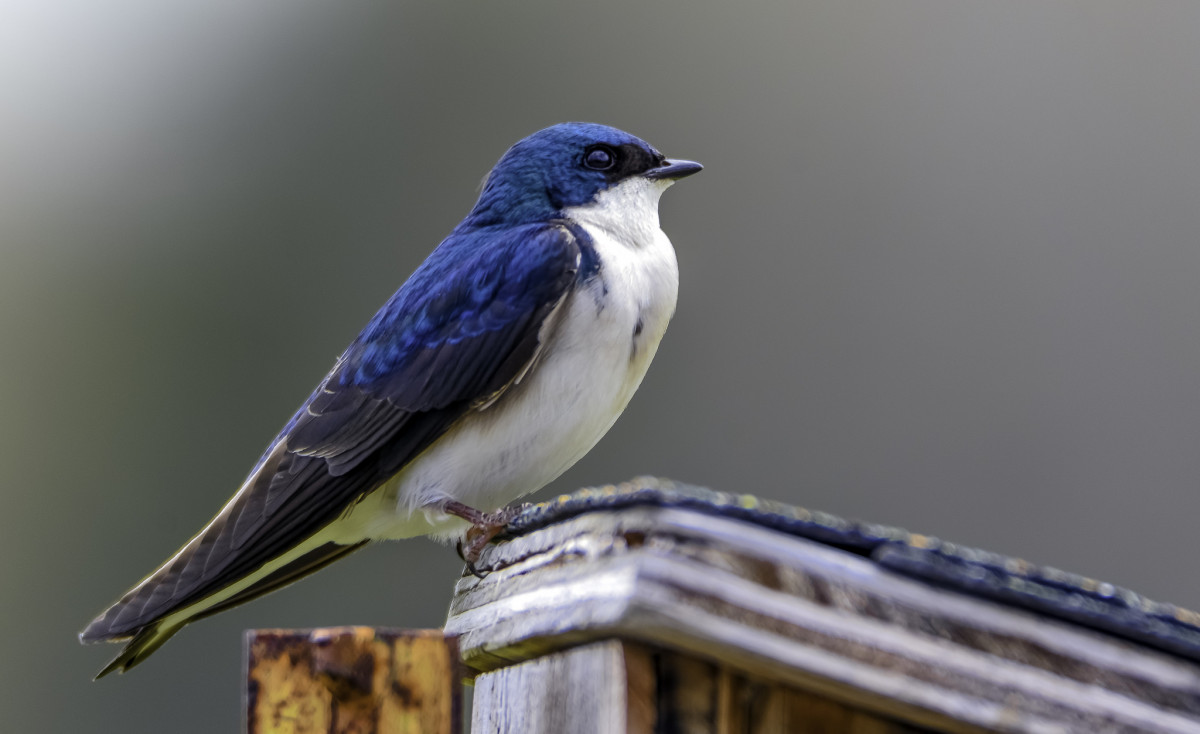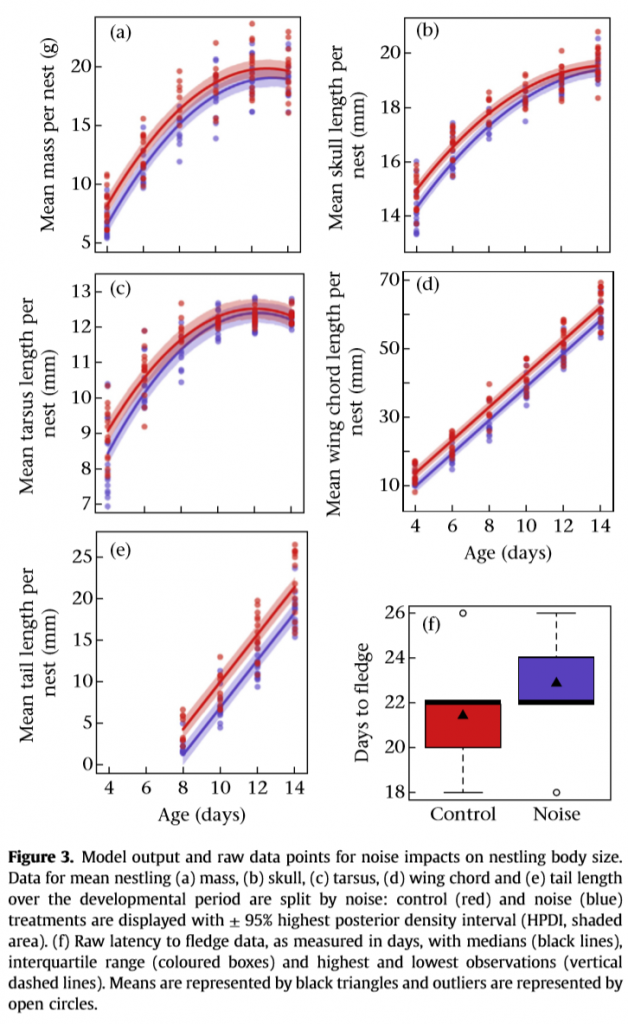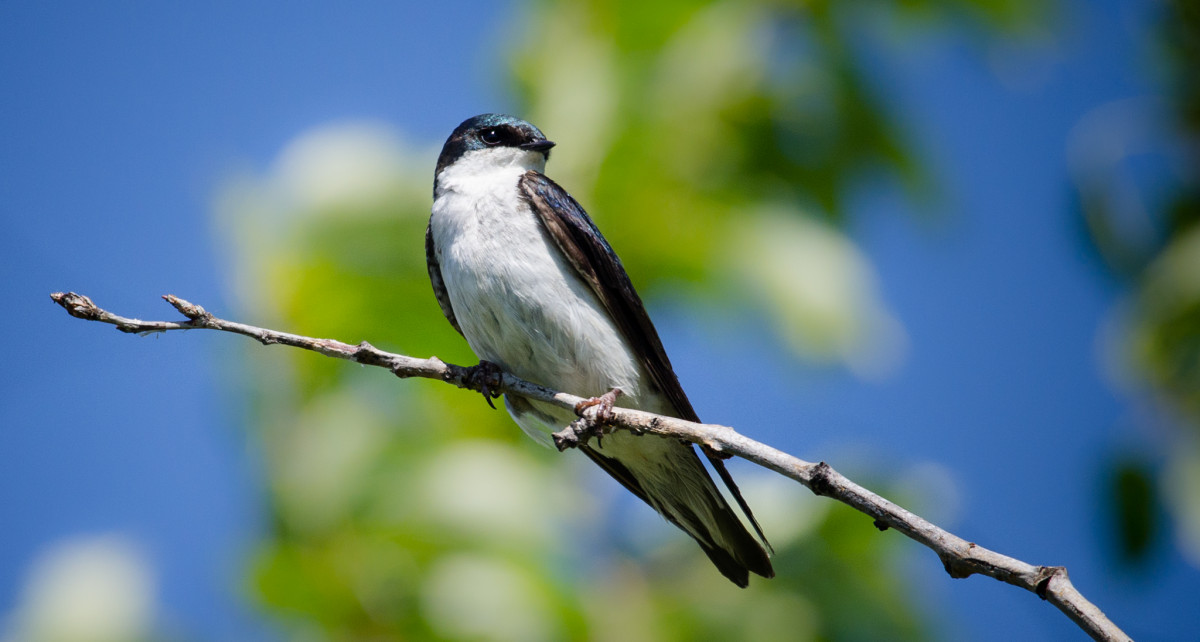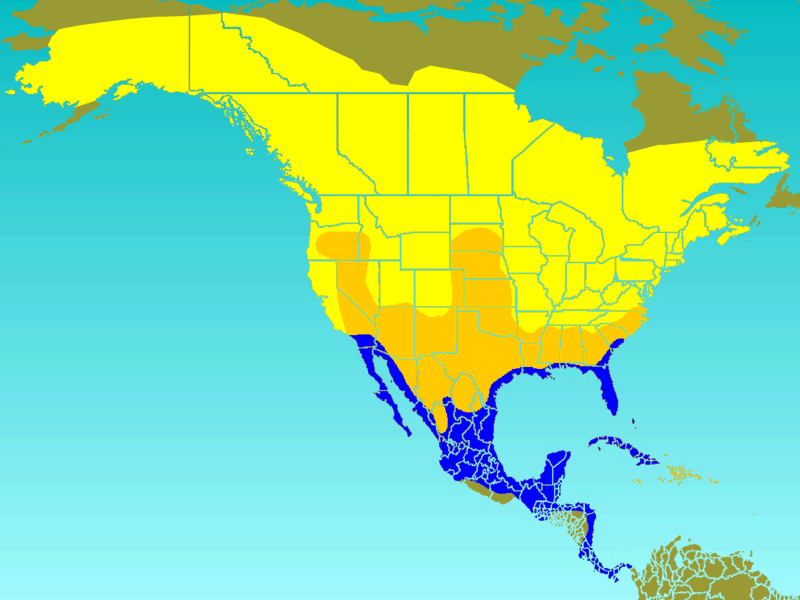
Male Tree Swallow (Credit: Charles Patrick Ewing on Flickr)
Order: Passeriformes
Family: Hirundinidae
Genus: Tachycineta
Scientific Name: Tachycineta bicolor
Introduction
The Tree Swallow (Tachycineta bicolor) is a tiny, streamlined songbird well known for catching flying insects in midair with their tiny, flat bill. They are recognized by their long, broad wings, a short, slightly notched or squared tail for making sharp turns when hunting. Both sexes reach a length of 12-15 cm, a wingspan of 30-35 cm (“using apa”, 2017), and a mass of ~20 g (Betini and Norris 2011). Males are recognized by their iridescent bluish-green plumage above, blackish flight feathers, a black lore, and white underparts, while females are duller with more brown in the upperparts with hints of blue-green.
The tree swallow is found throughout North America, but visits or stays in certain areas across the continent In the winter, tree swallows stay in areas like Mexico, the Southern USA and most of Central America, but can also make migratory stops along their migration routes in the Great Plains, eastern Oregon, and the southwestern and southeastern US.
The clip was accessed from https://www.all-birds.com/Sound and recorded by unknown.
CONSERVATION ISSUES
Currently, Tree Swallows face threats of decline by anthropogenic noise impact, reduction of aerial insect abundance, and spread of pesticides and other chemical particles into their body through food consumption.
In a study conducted by Cornell University and UC Davis, the adults guarding a nest exposed to noise for a short time experienced an decrease in vigilance during the early nesting period as well as smaller nests (Injaian, Taff, and Patricelli, 2017). Therefore, even when fed after an increase of foraging time by the adults, the nestlings were smaller than usual and took longer to fledge (Injaian, Taff, and Patricelli, 2017). This graph below shows that compared to the control nestlings (not exposed to noise), those exposed to anthropogenic noise had shorter body parts than the control. Out of these graphs, the nestling mass, tail length and wing chord length had the larger gaps in difference than skull and tarsus length.

Data showing how noise affects the size of nestlings in terms of length compared to control (A.S. Injaian et. al. 2017)
Noise at higher and moderate levels can also alter the interactions between parents and their offspring by reducing the parental response to begging calls and forcing the adults to spend more time foraging instead of returning when the chicks need them (Leonard, Horn, Oswald & McIntyre, 2015). Thus, extra begging from chicks due to these noise levels could be physiologically costly if adjustments are ineffective.
POPULATION TRENDS
The trend of the Tree Swallow population in the Northeastern part of North America is possibly experiencing some decline according to data taken by the North American Breeding Bird Survey (BBS) by 49% (1966-2014) due to the acidic NE soil that lacks calcium that insects and birds need (Shutler et al 2012). Overall, though, they are currently considered “least concern” and not in danger of extinction.
A survey analysis conducted for migratory birds in Dutchess County, NY (1885-2008) showed that Tree Swallows were significantly arriving earlier in spring than usual due to climate change, but it doesn’t affect their current population trend (Vitale and Schlesinger, 2011).

Bar graph showing % frequency of Tree Swallows observations in WA state 2009-2019 (Data downloaded from eBird and graphed on Excel 2013) (Every four weeks represents one month)
This histogram of the frequency in WA state observations from the last decade shows that Tree Swallows are seen less frequently during the non-breeding seasons and peaked in average frequency in the months of April and May.
- Injaian, A. S., Taff, C. C., & Patricelli, G. L. (2018). Experimental anthropogenic noise impacts avian parental behaviour, nestling growth and nestling oxidative stress. Animal Behaviour, 136, 31-39. doi:10.1016/j.anbehav.2017.12.003
- Shutler, D., Hussell, D. J., Norris, D. R., Winkler, D. W., Robertson, R. J., Bonier, F.,… Stanback, M. T. (2012). Spatiotemporal Patterns in Nest Box Occupancy by Tree Swallows Across North America. Avian Conservation and Ecology, 7(1). doi:10.5751/ace-00517-070103
- Winkler, D. W., Luo, M. K., & Rakhimberdiev, E. (2013). Temperature effects on food supply and chick mortality in tree swallows (Tachycineta bicolor). Oecologia, 173(1), 129-138. doi:10.1007/s00442-013-2605-z
- Beck, M. L., Hopkins, W. A., & Jackson, B. P. (2013). Spatial and Temporal Variation in the Diet of Tree Swallows: Implications for Trace-Element Exposure After Habitat Remediation. Archives of Environmental Contamination and Toxicology,65(3), 575-587. doi:10.1007/s00244-013-9913-5
- Wiebe, K. L. (2016, June 2). Interspecific competition for nests: Prior ownership trumps resource holding potential for Mountain Bluebird competing with Tree Swallow. Retrieved February 26, 2019, from http://americanornithologypubs.org/doi/full/10.1642/AUK-16-25.1
- Stanton, R., Morrissey, C., & Clark, R. (2016). Tree Swallow (Tachycineta bicolor) foraging responses to agricultural land use and abundance of insect prey. Canadian Journal of Zoology, 94(9), 637-642. doi:10.1139/cjz-2015-0238
- Cox, A. R., Robertson, R. J., Fedy, B. C., Rendell, W. B., & Bonier, F. (2018). Demographic drivers of local population decline in Tree Swallows (Tachycineta bicolor) in Ontario, Canada. The Condor, 120(4), 842-851. doi:10.1650/condor-18-42.1
- Betini, G. S., & Norris, D. R. (2012). The relationship between personality and plasticity in tree swallow aggression and the consequences for reproductive success. Animal Behaviour, 83(1), 137-143. doi:10.1016/j.anbehav.2011.10.018
- Vitale, J., & Schlesinger, W. H. (2011). Historical Analysis of the Spring Arrival of Migratory Birds to Dutchess County, New York: A 123-Year Record. Northeastern Naturalist, 18(3), 335-346. doi:10.1656/045.018.0306
- https://www.allaboutbirds.org/guide/Tree_Swallow/lifehistory
- Bradley, D. W., Clark, R. G., Dunn, P. O., Laughlin, A. J., Taylor, C. M., Vleck, C.,…Norris, D. R. (2014). Trans-Gulf of Mexico loop migration of tree swallows revealed by solar geolocation. Current Zoology, 60(5), 653-659. doi:10.1093/czoolo/60.5.653
- Harris, M. R., & Siefferman, L. (2014). Interspecific Competition Influences Fitness Benefits of Assortative Mating for Territorial Aggression in Eastern Bluebirds (Sialia sialis). PLoS ONE, 9(2). doi:10.1371/journal.pone.0088668
- Leonard, M. L., Horn, A. G., Oswald, K. N., & Mcintyre, E. (2015). Effect of ambient noise on parent–offspring interactions in tree swallows. Animal Behaviour, 109, 1-7. doi:10.1016/j.anbehav.2015.07.036



Leave a Reply